Looking back at Triumph’s off-road history, the brand’s forthcoming foray into the motocross and enduro segments all of a sudden makes a lot more sense.
Looking back at Triumph’s history, building expertise in all-terrain motorcycles is nothing new and can be dated all the way back to the early days of the company.
In the first world war, Triumph supplied more than 30,000 motorcycles to the allies, followed by about 46,000 in World War II. Triumph-branded machines were not an uncommon sight in the 1930s off-road racing scene, either, participating in major events like the Scottish and International Six Days Trials.
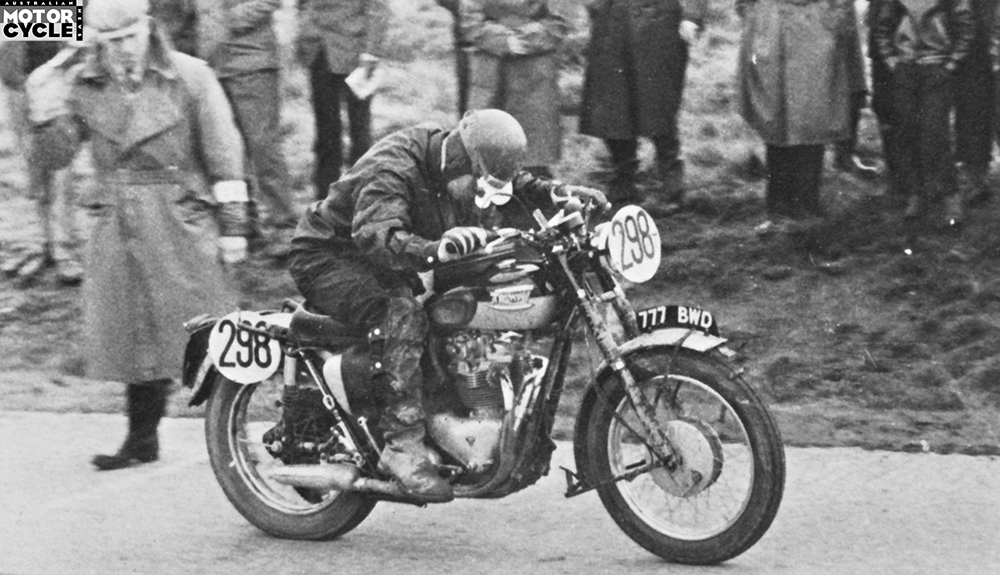
Triumph TR6 Trophy with works rider Ken Heanes ISDT 1962
But Triumph’s glory days in off-road bikes wouldn’t really kick in until the 1950s. The foundation for this was laid in 1937, when Triumph introduced the new 5T Speed Twin. This was a 500cc parallel twin designed by Edward Turner. Two years later, Triumph released a sportier version, the Tiger 100. Both models became so popular that Norton, Sunbeam, BSA, AMC and Royal Enfield also started producing parallel-twin models.
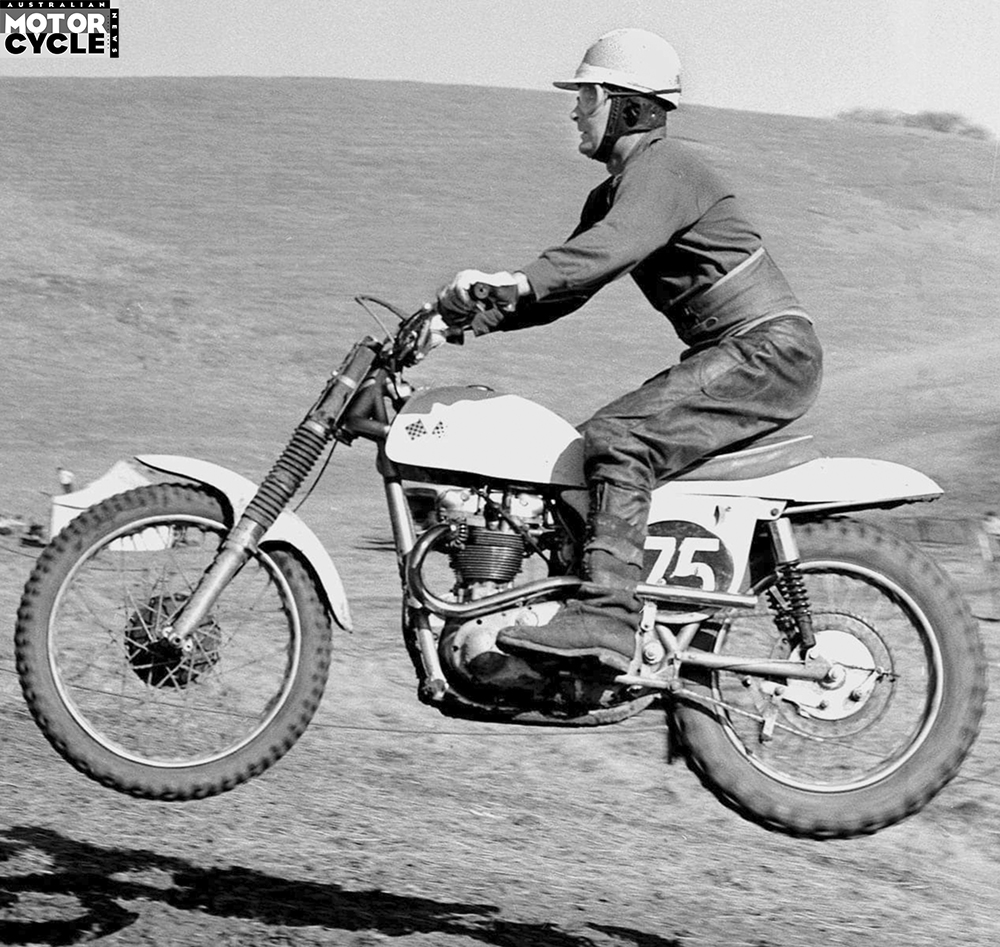
Metisse Triumph with Don Rickman during 1968 British GP on his Triumph engined Metisse 1968
When motorsport competition got back on track following the second world war, the question arose whether Triumph could supply and prepare a number of specially built motorcycles for the 1948 ISDT. The ‘Six Day’ was held in Sanremo that year, so Triumph decided to take the TR5 Speed Twin as a starting point. The engine was revamped and to optimise cooling it received the aluminium cylinder and head from a Triumph generator that had been produced in large numbers during the war. The frame and running gear were also modified and with success, too, because Trumpy’s factory riders Allan Jefferies, Bert Gaymer and Jim Alves all won gold medals and also picked up the team’s trophy.

Triumph Trophy 500 1970
This success led directly to the introduction of the new 500cc Triumph TR5 Trophy in 1949 which was a true all-terrain bike, almost identical to the ISDT machines of the previous year, and the Trophy moniker was a reference to the silverware Jefferies, Gaymer and Alves picked up at the 1948 ISDT. In fact, until the introduction of new-generation Triumphs out of the reborn Hinkley factory many years later, the name Trophy was very much associated with off-road machinery.

Triumph Trophy 650 1970
Triumph marketed the TR5 Trophy with the following text: “a machine completely designed to perform in the most difficult enduro and trial. It is lightweight, excellent in handling and the engine, although specially designed for traction at low revs, has enough power for the highest speeds when needed.”
It was a machine that could stand its ground both on and off the road; its top speed of 145km/h also spoke volumes in that regard.

Roosevelt Raceway NY – Tom Rockwood Triumph – 1972
The TR5 Trophy would become a successful all-terrain bike, with which many off-road successes were achieved in both Europe and America. Triumph even formed a factory team in the 1950s with English riders such as Jim Alves, John Giles and Peter Hammond who competed with great success in the tough English off-road races known as trials. Some examples of these are the National Vic Brittain Trial, the Cotswolds Cup Trial, the Bemrose Trial, the Lands End Trial and the Exeter Trial. Most famous were of course the Scottish Six Days Trial and the International Six Days Trial, the latter being held every year in a different country.
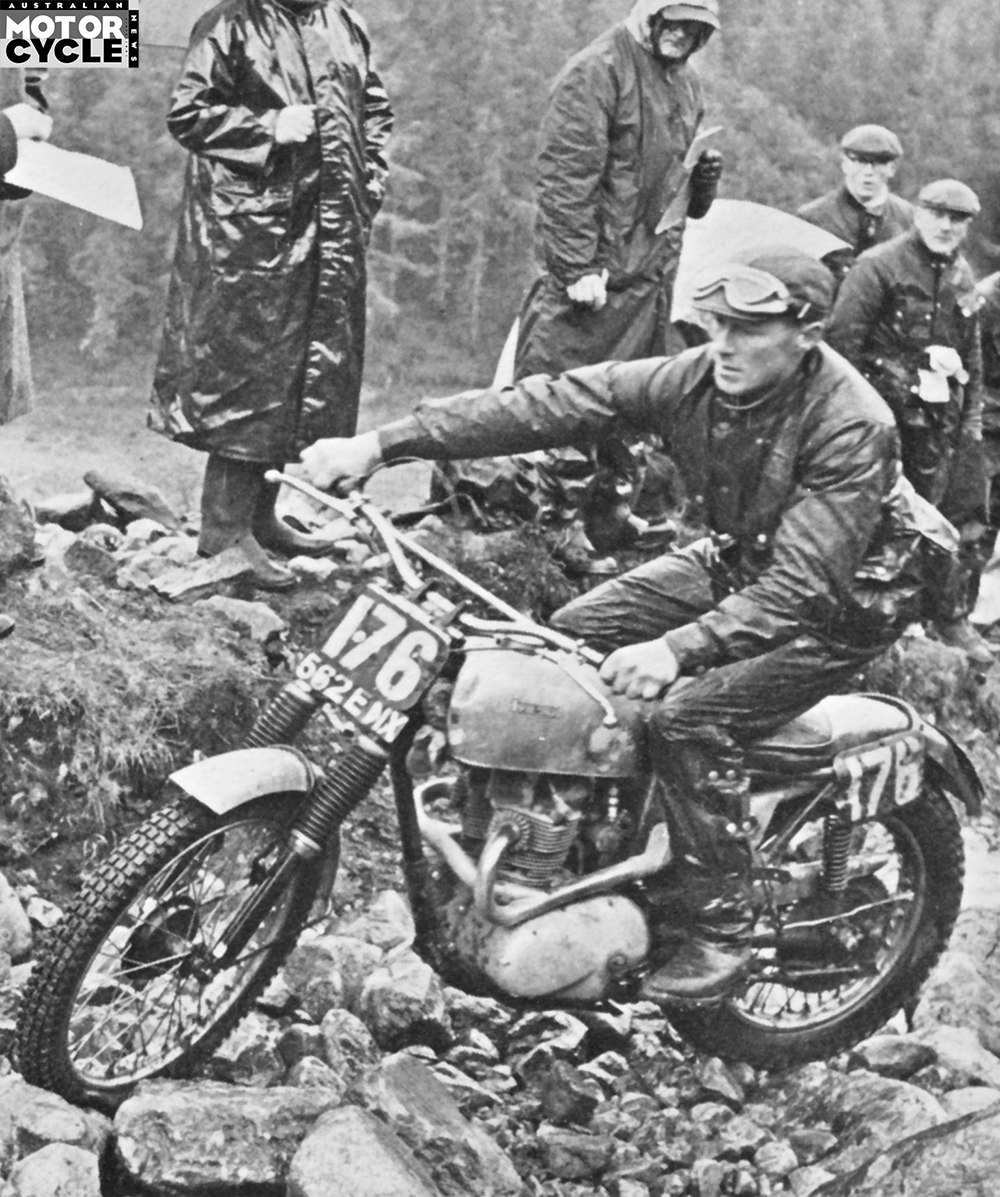
Triumph 500 TR5 Trial with Johnny Giles at Glasgow Trial 1961
Thanks to its high top speed, the TR5 Trophy was also a popular weapon in Southern California’s long hare and hounds desert races like the Big Bear Run and the ’49-ers Hare & Hounds Scramble. Sometimes more than 500 riders would participate in a single event.
But Triumph also excelled in more formal off-road events like the Catalina Grand Prix, held on an island close to Los Angeles. In addition, in America, it was widely used in the standard machine-derived AMA Class C off-road races. In Europe, TR5-based dirtbikes, specially developed by the Triumph factory for motocross, were also used. Factory rider Ken Heanes was a formidable competitor with his meticulously prepared Triumph Scrambler motocross machines.

Triumph TR5T Trophy Trail 1973
In 1952, Triumph introduced the T15 Terrier, a lightweight motorcycle powered by a slightly forward-sloping 149cc single-cylinder two-valve four-stroke engine. Motorcycles under 150cc enjoyed loads of tax benefits in England. In appearance, it looked a bit like its bigger Speed Twin brother. The T15 Terrier went into production in early 1953 and immediately became very popular. It dabbled in off-road work, but the big off-road success came when the slightly heavier 199cc T20 Tiger Cub was introduced the same year. Initially, just like the Terrier, it had a plunger rear suspension, but soon a rear swingarm replaced it. When the Terrier was withdrawn from production in 1956, the T20 Tiger Cub really started performing well. The T20C Tiger Competition was launched in 1957.
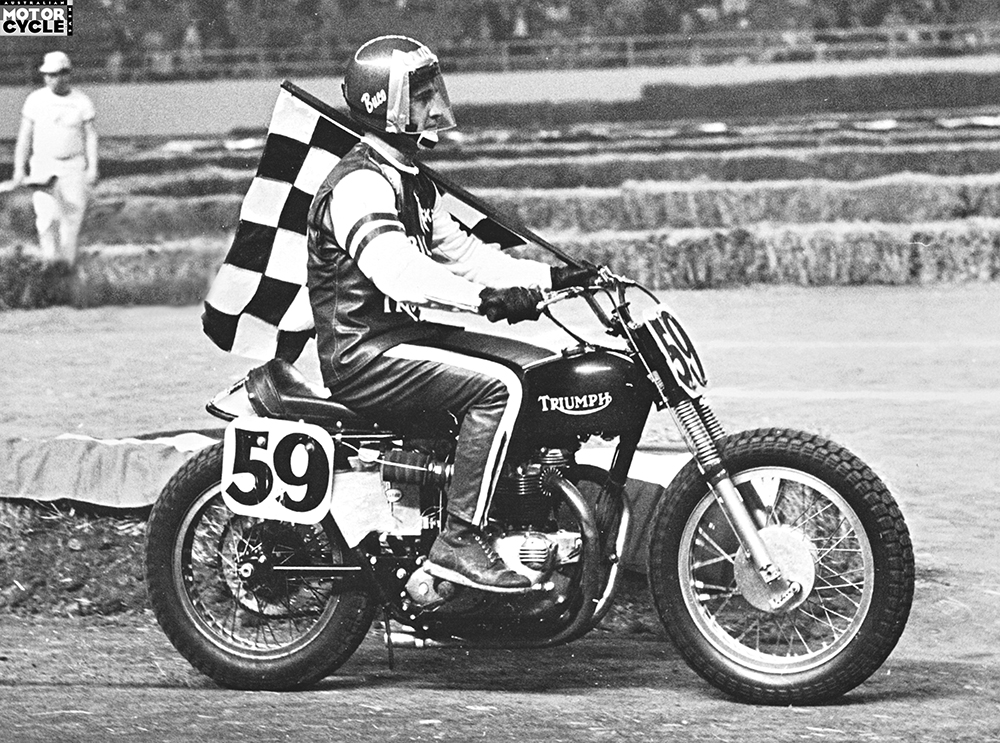
Triumph dirttrack ace Skip Van Looney – Houston Astrodome – 1970s
This model was derived from the factory T20 with prototype swingarm frame used by George Fisher in the 1956 Scottish Six Days Trial. Ken Heanes used the same machine to win a gold medal in that year’s ISDT. The T20C was derived from this factory machine and became hugely successful in off-road terrain. And it didn’t take long before the T20C in various versions became one of the most successful off-road models in Triumph’s history.
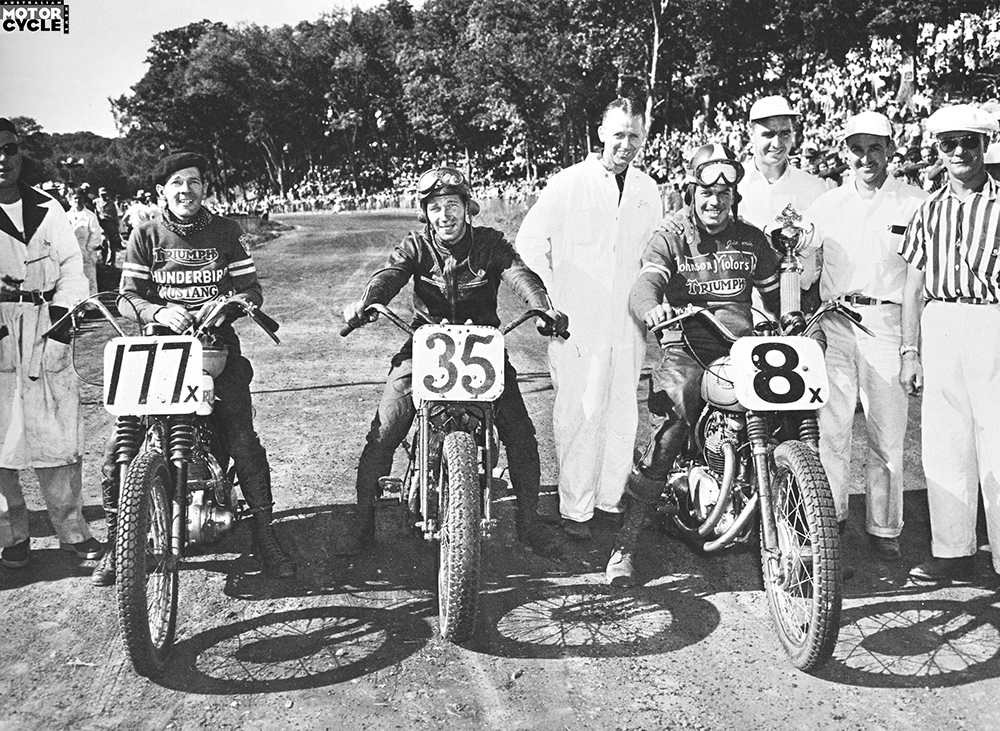
Triumph dirttrack Peoria TT Illinois 1951 – nr 177 Walt Fulton winner – nr 35 Miller HD nr8 Jimmy Phillips – 1951
In 1959 Roy Peplow won the Scottish trial with a T20C Tiger Competition. It was the first overall win in the Scottish for a small-capacity motorcycle! No other Triumph model managed to take as many victories in prestigious enduros such as the ISDT and the Scottish six-days, desert races, hill climbs, drag races, dirt track, scrambles, speedway, trial and even ice racing. A 199cc Tiger Cub even set a world speed record at Bonneville with a speed of 223.712km/h, covering one run at a speed of 238.904km/h. The Tiger Cub would eventually go out of production in 1967.

Triumph TR65T Tiger Trail 650cc 1981
In 1956 a heavier version of the 500cc Trophy came on the market, the 650cc TR6 Trophy. After the Second World War, there was a demand for a heavier version of the Speed Twin, especially in America, which was, even then, by far Triumph’s largest sales market. Triumph responded with the 650cc 6T Thunderbird, presenting it in 1949 as a new model for 1950. In 1956 the TR6 Trophy came on the market. It was a combination of the 650cc Tiger 110 sport version of the Thunderbird and the TR5 Trophy. Compared to the T110, the cylinder head was made from aluminium and the compression ratio was slightly higher at 8:1. Just like the TR5 it was available as an all-terrain bike and, when equipped with equipment such as lighting and a low-slung exhaust system, also as a sporty road model. The off-road version became immensely popular in America and was a true sales success. With minimal changes, the TR6 Trophy was transformed into the ideal desert racer. Many people did this and it was soon nicknamed ‘Desert Sled’. The model also performed extremely well in dirt-track racing.
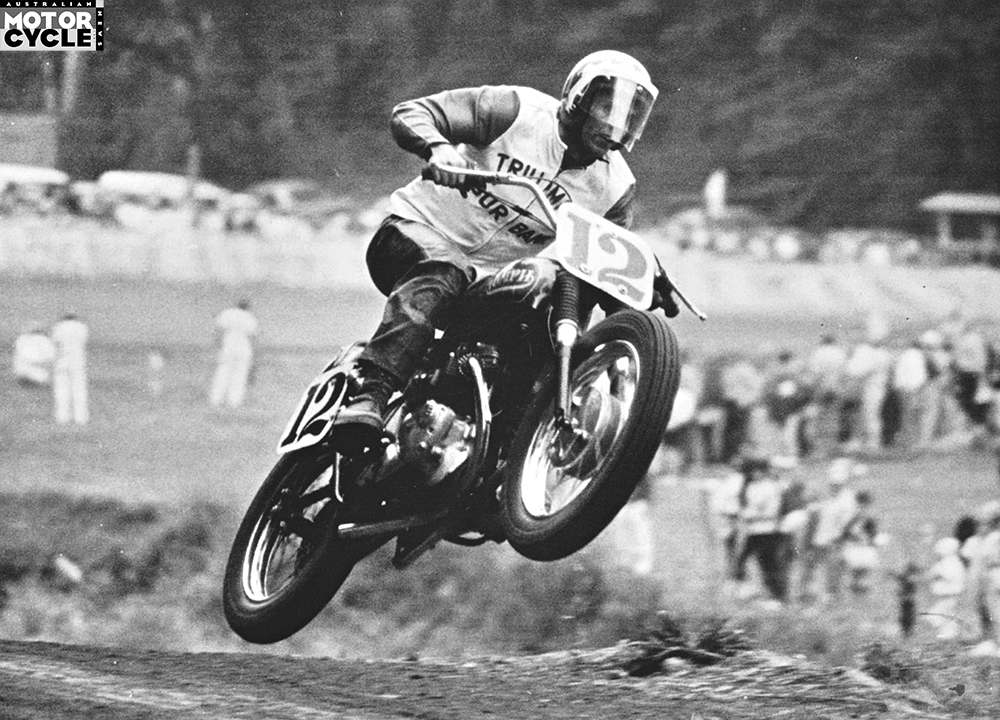
Castle Rock TT – Squirrel Mulder – Triumph – 1965
Although Triumph introduced the 650cc T120 Bonneville in 1959, this did not affect the popularity of the TR6 Trophy whatsoever. The engine power did not differ much and the TR6 Trophy had already achieved a legendary off-road reputation when the Bonnie debuted which, incidentally, was also used off-road, especially in dirt-track racing. For the heavier enduros, however, the TR6 Trophy remained the favourite. The model also performed excellently in the ISDTs of that period. In 1964 during the ISDT in southern Germany it was used by none other than Steve McQueen, who was part of the American ISDT team. McQueen was an avid off-roader and was friends with stuntman, off-road racer and Triumph dealer Bud Ekins. Thanks to him, the TR6 Trophy was also used in the movie The Great Escape.
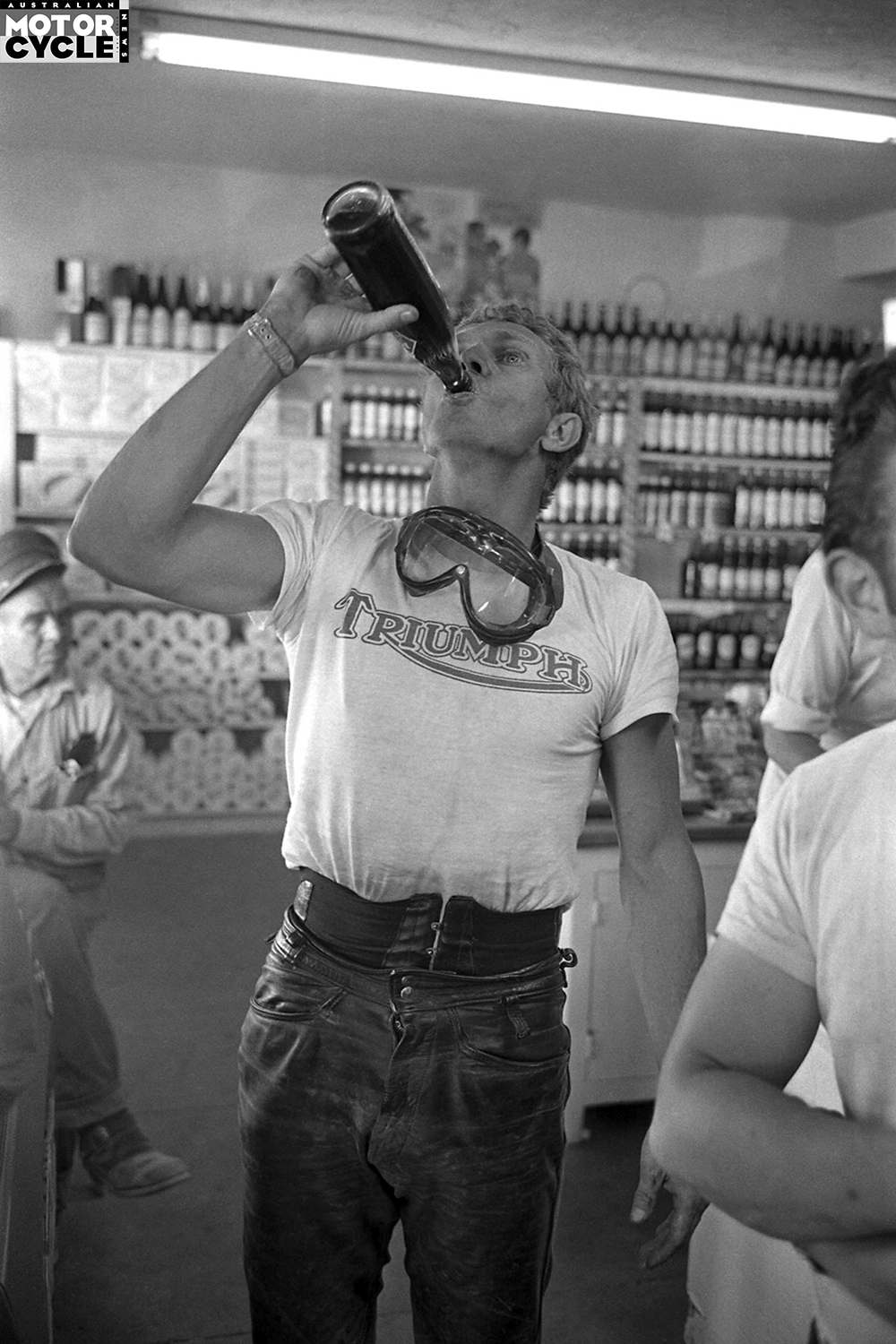
McQueen takes a deep swig of a tall, cool drink, 1963
McQueen was a true Triumph fan who loved the TR6 Trophy, but his favourite desert racer was his 1966 Triumph Métisse Mark 3 TR6. The Métisse motorcycle company was founded in the late 1950s by brothers Derek and Don Rickman, two of the most successful English motocross racers of the 1950s and 1960s. Initially, they rode with standard BSAs that they modified with a variety of parts from various suppliers. This mix eventually resulted in a rather potent motorcycle that the brothers dubbed ‘Métisse’, the French word for bastard.

Metisse Triumph Steve McQueen limited-edition Desert Racer 2021
At the end of the 1950s, they built an off-road special, the Tribsa Métisse. Frame, gearbox, triple clamps and rear hub came from a BSA, the front fork came from a Norton and the engine was a tuned Triumph Tiger 100. The result was so successful there was an immediate demand, which led Rickman to decide to build these machines in series.

Metisse Triumph Steve McQueen limited-edition Desert Racer with Rickman brothers Don and Derek
Back then, the BBC broadcasted motocross races on Saturday afternoons and because of that Rickman quickly became very known. This created a strong demand for Métisse replicas, a demand that the Rickmans were happy to oblige to. When the popularity of the Tribsa Métisse was starting to wane, the brothers were already working on something new.
They had decided in 1960 to design their own motorcycle; they created a new, lightweight frame to fit a Matchless G80 engine. Shortly afterwards, a version was developed that was suitable for a Triumph engine. This time the demand for these new Métisse Mark 3 frames exploded and for the first time, there was also interest from abroad. From that moment on Rickman would grow very quickly and the construction of a new factory soon became necessary. Rickman would eventually build 2000 of these Mk. 3 frames, and once they left the factory the bikes would be completely assembled as desired and equipped with a 500cc Triumph Tiger 100 engine.
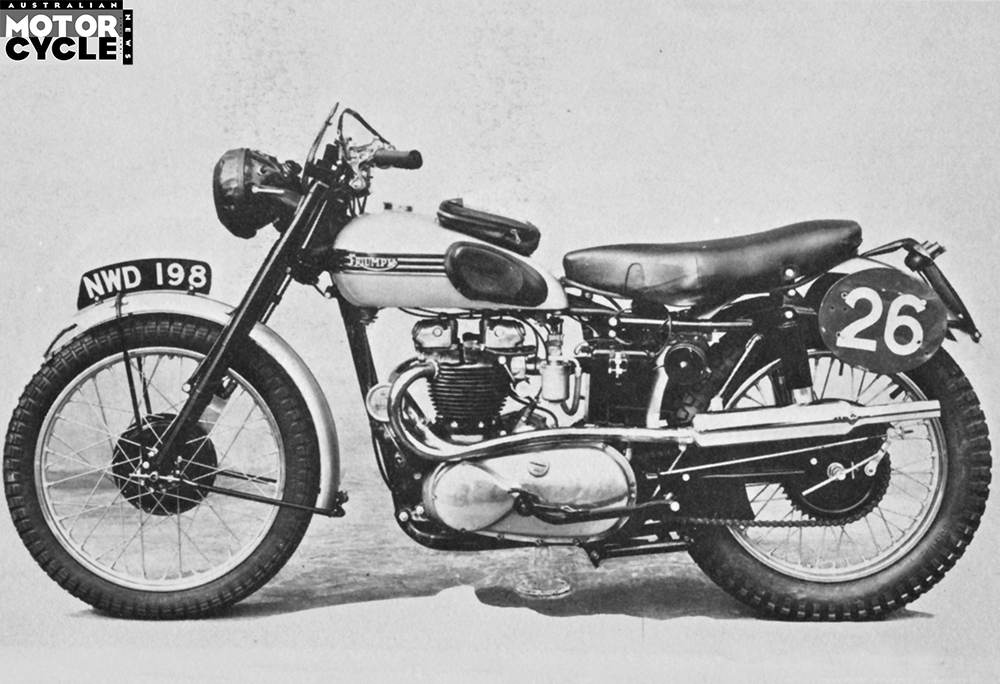
Triumph ISDT 650cc prototype with rear swingarm 1953
The bike had the handling characteristics of which all Métisses would become famous, mostly because of its excellent frame. It was constructed from chrome-molybdenum Reynolds 531 tubing, making it lighter, stronger and more rigid then a steel frame. On average the Métisse weighed about 15kg less than most of its counterparts, which were usually derived from stock machines. In addition, the Métisse also carried the engine oil of the dry-sump engines in the frame, partly cooling it while also making a separate oil tank unnecessary.

Triumph Tiger Trials Cub 1960
The Métisse frame concept was immediately successful. Don Rickman finished fourth in the 1960 500cc motocross world championship while Derek won the European motocross championship in the 750cc class. Both continued to achieve success while at the same time further developing their chassis and bikes.
Today, the Triumph Métisse is still one of the ultimate Triumph off-road bikes. In 1966 Steve McQueen ordered a Rickman Métisse Mark 3 chassis with a Triumph TR6 Trophy engine and it became his favourite off-road racer. Today, Métisse Motorcycles makes replicas of this machine and together with Rickman Motorcycles they supply complete machines and frame kits.
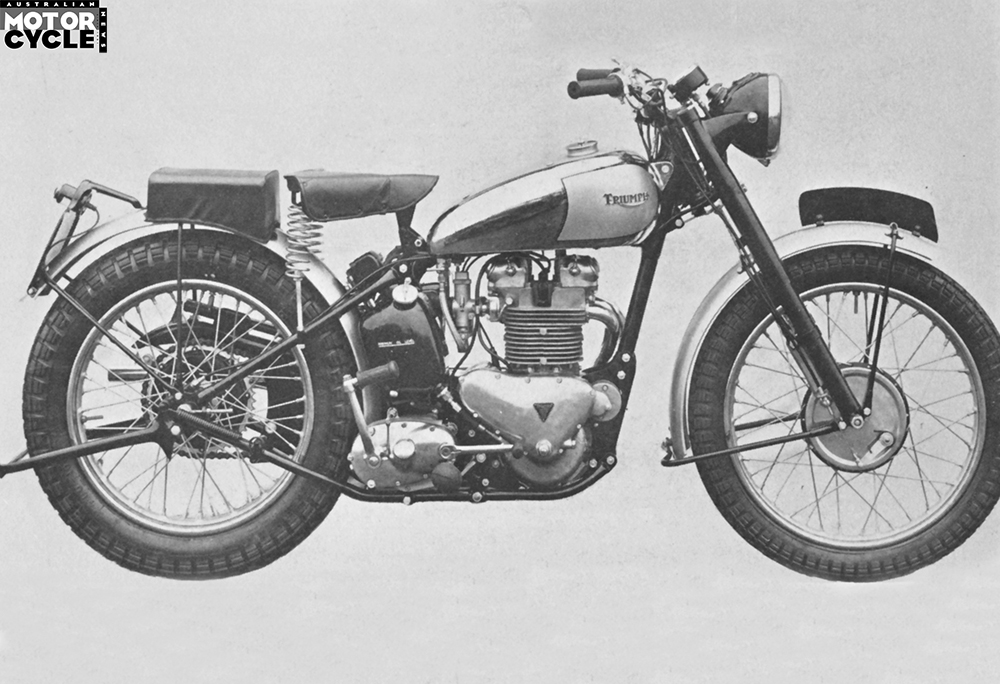
Triumph TR5 Trophy 1949 FIRST VERSION
In 1963 Triumph introduced new engines on the TR6 Trophy and the other parallel-twin models. The engine drive and gearbox components now received a single casing, while the two-valve twin-cylinder engine retained the three-piece crankshaft with a flywheel in the middle. The camshafts were placed high in the horizontally split crankcase, the intake shaft at the rear of the engine and the exhaust camshaft at the front. It measured 71 x 82mm, the compression ratio was 8.5:1 and the engine power was 40hp at 6500rpm.

Triumph TR6 Trophy with works rider Ken Heanes ISDT 1962
In 1971, the stronger, oil-bearing frames were introduced at Triumph. This frame would be used for the TR6 Trophy for two years because in 1973 the model went out of production. The new 750cc TR7 became its replacement, in America, this machine remained competitive in dirt-track racing for many years. In 1971 the renewed Trophy 500 was also introduced complete with the oil-bearing frame. In 1973 it was succeeded by the TR5T Trophy Trail, which would become successful in the 1973 ISDT.
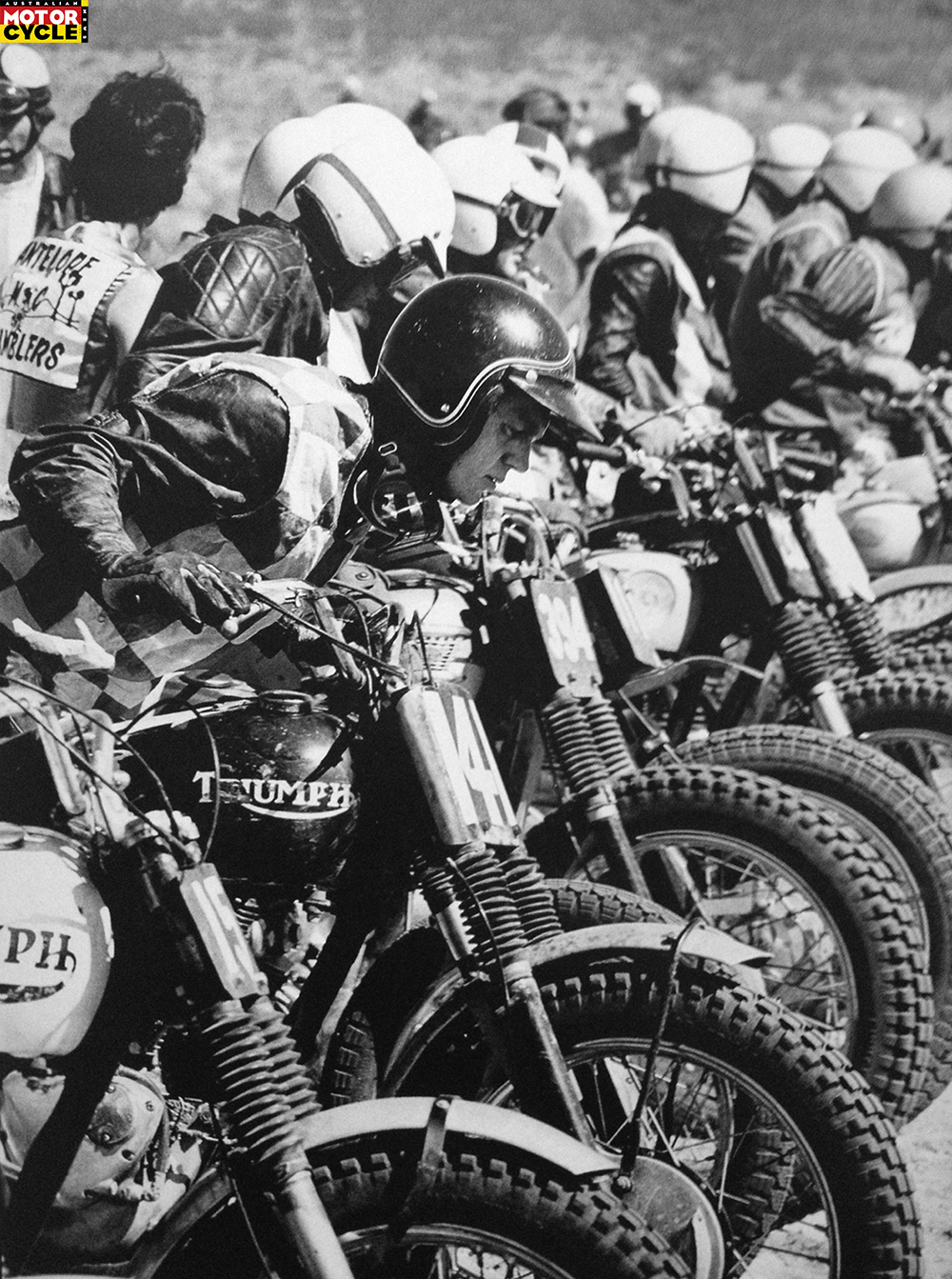
Steve McQueen – On Any Sunday – 1970
After that, Triumph entered deeper and deeper financial troubles. The rise of the lightning-fast and very light two-stroke off-road motorcycles meant that the production of Triumph’s off-road motorcycles became much less important. That changed in 1981 when the new Triumph Tiger Trails came on the market in two versions, the 650cc TR65T and the 750cc TR7T. This was Triumph’s answer to the BMW GS series.

Ascot 1975 – Gary Scott Triumph sponsored by Evel Knievel – 1975
The models were not a success, partly because they were not allowed on the American market due to strict environmental requirements that the Triumphs could not meet. Both models were taken out of production at the end of 1982 due to lack of demand, popularity only ever having been gained in Australia, Germany, the Netherlands and Switzerland. The last TR7T was produced as part of a British Ministry of Defence order. It was kept in active duty from August 1982 to April 1989.
So while Triumph’s announcement earlier this year to have a red hot go at the enormously competitive but equally lucrative motocross and enduro segments may have come as a surprise to many, the decision is perfectly suited to the company’s rich history of off-road racing success.
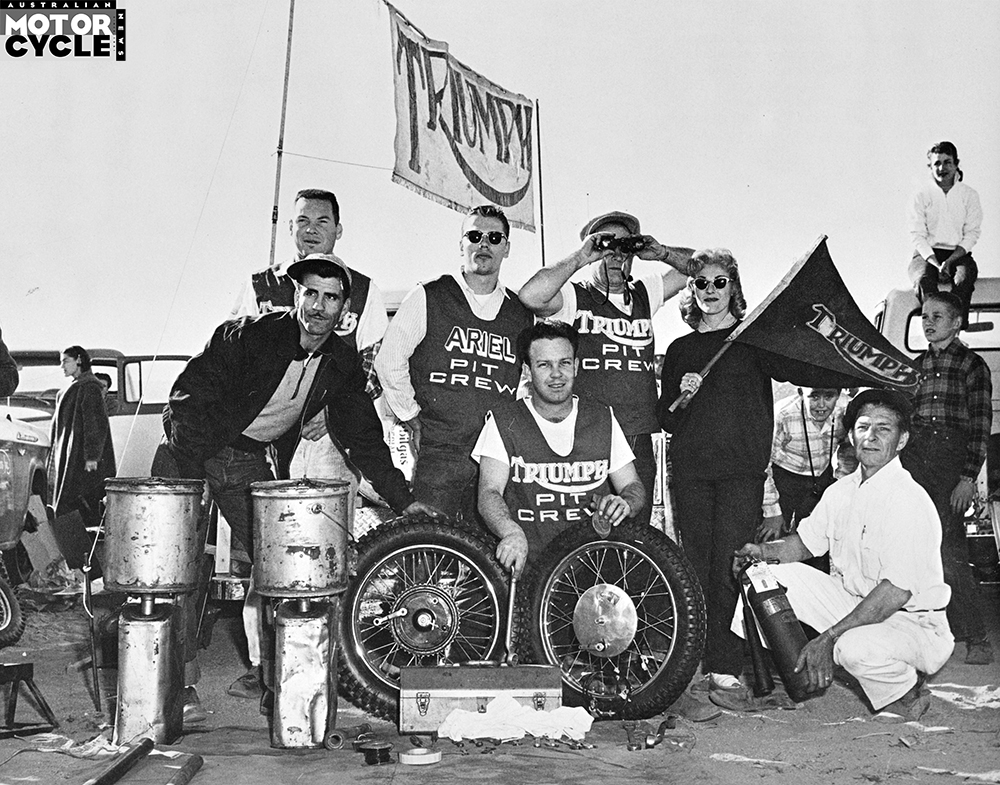
Triumph USA Johnson-Motors pit crew Big Bear run 1959. Triumph won-1, 2, 3
See latest article on Tiger 1200 Adventure here,
Words Ivar de Gier
Photography Archives A Herl